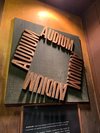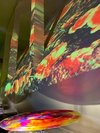



Jennifer Waits ventures to Audium, San Fransisco's longstanding "Theater of Sound-Sculptured Space", for its first ever Artist-in-Residence program titled "New Voices". It's up until April 2, 2022.
Eerie shadows stretch upward from an elevated perch in an otherwise dark theater, as ominous music reaches unseen audience members’ ears through 176 speakers. It’s pitch black, save for tentacles of illumination and, at times, a purple-ish glow emanating from flashlights used by composer Victoria Shen to activate a MIDI controller that she built for the space. Her piece, “Terpsichore,” caps off an evening of immersive sounds by the three artists-in-residence at Audium in San Francisco. With performances every weekend from February 10 through April 2, 2022, the Audium: New Voices series heralds the latest phase for the “theater of sound,” which has occupied its current location since 1975; its history stretches back to the 1960s.


Photo by author
Although darkness is a critical part of the theater experience at Audium, the slivers of light during Shen’s set were an alluring invitation to solve the mystery of what the artist was up to during the show. The third performance of the night, Shen was the sole artist leaving visual traces while in the theater. Composers Noah Berrie and Alexa Burrell preceded her, doing each of their sets in complete darkness. I couldn’t help but fixate on the glimmers of light along with the mesmerizing (and satisfyingly unnerving) sounds created by Shen; during the other two performances I found myself closing my eyes. Each set brought me into a dream-like state, but the journeys were quite different.
The show opened with Noah Berrie’s “Organ Music.” The first sounds that I picked up, as the theater lights dimmed, were breathing noises, voices, and a sneeze. It was a weird sensation to be hearing some of these bodily sounds all around me, wondering if any were coming from virus-filled humans seated nearby. As the piece progressed, there were creaks and rumbles, as well as more orchestral parts, and unsettling moments with whispering voices. Although I couldn’t see it, Berrie was using a custom-built instrument called the Othervoice, consisting of a ring of transducers attached to his throat. Berrie described how it works, telling me, “It activates the resonances of my vocal cavity and allows me to filter sounds with my body. For the live performance, I'm mouthing phrases, contorting my face, and moving my head around to shape a 'solo' performance that reacts and responds to the 'ensemble' of sounds in the space.”
Voices were also a central element of Alexa Burrell’s “A(Void) Fire,” which included beautiful singing, gorgeous wordless vocals, as well as anxiety-producing fragments of language. Described in the program as “an afro-surrealist techno-horror fairytale about a Black woman who is haunted by a demonic embodiment of her comfort zone,” its sung and spoken lyrics referenced worries, heart rate, and “the edge of this broken world.” Before and after the theater performance, a film by Burrell played in the lobby, amplifying the themes in the audio-only piece. She explained her work further to me, saying, “My films explore the contradictions I feel between the digital and biological worlds. I've been looking at inflammation on all scales - from my attention span, my body and our planet. So much is going on and it's so easy to be overstimulated. I felt like the sonic composition in the dark was the intersection or crossroads where all these differing realities come to a head.”
An interesting aspect of Audium is that the artists all built their own tools to control how their sounds travel through the theater’s nearly 200 speakers. Burrell explained to me that although her music was prerecorded, each show is unique, allowing for improvisation as she makes decisions in the moment while “switching between the many different types of speakers.” She added that “Audium is truly an instrument and I am still learning so much technique!”
Listening to Shen, Burrell and Berrie’s audio pieces in the dark theater was otherworldly, and the absence of visuals allows for a deeply meditative experience. I was similarly moved by the kaleidoscopic projections, psychedelic sound sculptures, and spooky films in the lobby. Each artist contributed to the space, which provided a nice complement to the theater show. I kept returning to take a closer look at Shen’s colorful records (some spinning and some static) in the area leading directly to the theater entrance. With ink-blot like patterns reminiscent of tie-dye and old school San Francisco liquid light shows, they were a fitting pairing in a space dating back to the 1970s with a history nestled up against the Summer of Love.

Victoria Shen's work in Audium Lobby (Photo by author)

Audium Lobby - Photo by author

